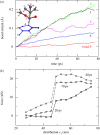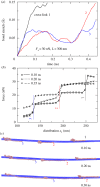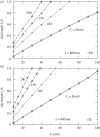Interfacial load transfer mechanisms in carbon nanotube-polymer nanocomposites
- PMID: 30220863
- PMCID: PMC6127397
- DOI: 10.1098/rspa.2017.0705
Interfacial load transfer mechanisms in carbon nanotube-polymer nanocomposites
Abstract
Carbon nanotubes (CNTs) are highly promising for strength reinforcement in polymer nanocomposites, but conflicting interfacial properties have been reported by single nanotube pull-out experiments. Here, we report the interfacial load transfer mechanisms during pull-out of CNTs from PMMA matrices, using massively- parallel molecular dynamics simulations. We show that the pull-out forces associated with non-bonded interactions between CNT and PMMA are generally small, and are weakly-dependent on the embedment length of the nanotube. These pull-out forces do not significantly increase with the presence of Stone Wales or vacancy defects along the nanotube. In contrast, low-density distribution of cross-links along the CNT-PMMA interface increases the pull-out forces by an order of magnitude. At each cross-linked site, mechanical unfolding and pull-out of single or pair polymer chain(s) attached to the individual cross-link bonds result in substantial interfacial strengthening and toughening, while contributing to interfacial slip between CNT and PMMA. Our interfacial shear-slip model shows that the interfacial loads are evenly-distributed among the finite number of cross-link bonds at low cross-link densities or for nanotubes with short embedment lengths. At higher cross-link densities or for nanotubes with longer embedment lengths, a no-slip zone now develops where shear-lag effects become important. Implications of these results, in the context of recent nanotube pull-out experiments, are discussed.
Keywords: carbon nanotubes; cross-link bonds; molecular dynamics; polymer nanocomposites; shear-slip.
Conflict of interest statement
We have no competing interests.
Figures











References
-
- Zhang S, Mielke SL, Khare R, Troya D, Ruoff RS, Schatz GC, Belytschko T. 2005. Mechanics of defects in carbon nanotubes: atomistic and multiscale simulations. Phys. Rev. B 71, 115403 (10.1103/PhysRevB.71.115403) - DOI
-
- Tsuda T, Ogasawara T, Deng F, Takeda N. 2011. Direct measurements of interfacial shear strength of multi-walled carbon nanotube/PEEK composite using a nano-pullout method. Compos. Sci. Technol. 71, 1295–1300. (10.1016/j.compscitech.2011.04.014) - DOI
-
- Ding W, Calabri L, Kohlhaas KM, Chen X, Dikin DA, Ruoff RS. 2007. Modulus, fracture strength, and brittle vs. plastic response of the outer shell of arc-grown multi-walled carbon nanotubes. Exp. Mech. 47, 25–36. (10.1007/s11340-006-9344-6) - DOI
LinkOut - more resources
Full Text Sources
Other Literature Sources

